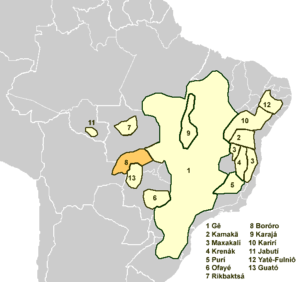Bororoan languages
The Borôroan languages of Brazil are Borôro and the extinct Umotína and Otuke. They form part of the proposed Macro-Jê language family.
| Borôroan | |
|---|---|
| Geographic distribution | Brazil |
| Linguistic classification | Macro-Gê
|
| Glottolog | boro1281[1] |
 Geographical distribution of the Borôroan languages | |
They are called the Borotuke languages by Mason (1950), a portmanteau of Bororo and Otuke.[2]
Kaufman (1994) suggests a relationship with the Chiquitano language.[3]
Language contact
Jolkesky (2016) notes that there are lexical similarities with the Guato, Karib, Kayuvava, Nambikwara, and Tupi language families due to contact.[4]
Cariban influence in Bororoan languages was due to the later southward expansion of Cariban speakers into Bororoan territory. Ceramic technology was also adopted from Cariban speakers.[4]:415 Similarly, Cariban borrowings are also present in the Karajá languages. Karajá speakers had also adopted ceramic technology from Cariban speakers.[4]:420
Similarities with Cayuvava are due to the expansion of Bororoan speakers into the Chiquitania region.[4]:416
Languages
The relationship between the languages is,[5]
See Otuke for various additional varieties of the Chiquito Plains in Bolivia which may have been dialects of it, such as Kovare and Kurumina.
There are other recorded groups that may have spoken languages or dialects closer to Borôro, such as Aravirá, but nothing is directly known about these languages:[6]
- Aravirá - extinct language once spoken on the Cabaçal River and Sepotuba River in Mato Grosso
- Orari (Eastern Borôro, Orarimugodoge) - spoken on the Valhas River, Garças River, and Madeira River in Mato Grosso
Vocabulary
Loukotka (1968) lists the following basic vocabulary items.[6]
gloss Boróro Orari Umutina Otuque tongue i-táuro i-kaura azoː ki-taho hand i-kéra i-kera azyida seni fire yóru dzyóru zoːruː reru stone tori tori tauri tohori sun kueri meri baru neri moon ári ari aːliː ari earth róto mottu moto moktuhu jaguar adúgo adugo azyukuetá anteko fish kare karo haré aharo house bái bai isipá huala bow baíga voiga bóika vevika
Proto-language
For a list of Proto-Bororo reconstructions by Camargos (2013),[7] see the corresponding Portuguese article.
Further reading
- Camargos, L. S. (2013). Consolidando uma proposta de Família Linguística Boróro. Contribuição aos estudos histórico-comparativos do Tronco Macro-Jê. Doctoral dissertation. Brasília: Universidade de Brasília.
- Ochoa, G. C. (1995). Dicionário Bororo-Português. Campo Grande: Missão Salesiana de Mato Grosso.
- Schultz, H. (1951). Vocabulário dos indios Umutína. Journal de la Société des Américanistes de Paris, 41:81-137. (1955). Vocabulos Urukú e Digút. Journal de la Société des Américanistes, 44:81-97.
References
- Hammarström, Harald; Forkel, Robert; Haspelmath, Martin, eds. (2017). "Bororoan". Glottolog 3.0. Jena, Germany: Max Planck Institute for the Science of Human History.
- Mason, John Alden (1950). "The languages of South America". In Steward, Julian (ed.). Handbook of South American Indians. 6. Washington, D.C., Government Printing Office: Smithsonian Institution, Bureau of American Ethnology Bulletin 143. pp. 157–317.
- Kaufman, Terrence. 1994. The native languages of South America. In: Christopher Moseley and R. E. Asher (eds.), Atlas of the World’s Languages, 59–93. London: Routledge.
- Jolkesky, Marcelo Pinho de Valhery (2016). Estudo arqueo-ecolinguístico das terras tropicais sul-americanas (Ph.D. dissertation) (2 ed.). Brasília: University of Brasília.
- Loukotka, Čestmír (1968). Classification of South American Indian languages. Los Angeles: UCLA Latin American Center.
- Camargos, Lidiane Szerwinsk. 2013. Consolidando uma proposta de Família Linguística Boróro: contribuição aos estudos histórico-comparativos do Tronco Macro-Jê. Doctoral dissertation, University of Brasília. (PDF).